Rabbit ownership has increased by approximately 0.2 million rabbits in the last 3 years (equivalent of 8.3% of cat or dog populations), and at the start of 2022 there were 1 million pet rabbits in the UK (Pet Food Manufacturers' Association, 2022). However, it is reported that only 2% of patients registered with vets are rabbits, compared with 64.8% dogs and 30.3% cats (Sánchez-Vizcaíno et al, 2017). This indicates that there is a large deficit in the numbers of rabbits being seen in veterinary practices and, therefore, support being given to owners regarding husbandry, education and welfare (including veterinary care) cannot be assessed and addressed. Nurses have a key part to play in encouraging rabbits into the veterinary practice, as their skill set can be applied to rabbits as much as cats and dogs.
Pre-ownership clinics
Any owner should be encouraged to do research if they are considering taking on a pet. A study by Winnepenninckx (2020) showed 65.5% of rabbit owners gain their information from online sources, despite the fact that information available online is not always reliable. It is for this reason nurses and veterinary support staff can play a key role in owner education. Ideally, this should be done before the animal is acquired, but veterinary practices are usually only aware of the new addition at registration. Education from the veterinary practice after ownership still shows benefits for pets compared with no education (Nicholas, 2018).
These education consultations aim to ensure that the client can get the ownership correct from the start. This can help eliminate husbandry-related conditions and aid preventative care compliance and early detection of ill health. These consultations are a first point of contact for the client to have their animal seen, feel supported and make a loyal connection to the practice. These consultations should aim to discuss preventative health care, husbandry, care throughout the life of the rabbit, life expectancy and diseases commonly linked to specific breeds. Discussing husbandry and correct care can also build confidence in the relationship as the client realises that the veterinary nurse knows about their pet and how to care for them. Written information packs should be provided, because clients will likely only remember four things from a consultation (Ackerman, 2012), so giving reference and contact details is beneficial. Ackerman (2012) also indicates that clients leaving a consultation with something, even literature, feel more positive and that they have received a service.
Top-to-tail health checks
Routine health checks can be a good opportunity to assess the general health status of the individual. It allows intervention for common conditions seen by the veterinary team which owners might be less likely to identify, such as obesity, arthritis or pododermatitis. It can also create an opportunity to see and address changes which could other-wise go unnoticed, especially in older rabbits.
A full physical examination is essential, as rabbits are prey species that are very adept at hiding signs of illness. A distance examination is useful to assess the demeanour and more general signs of illness. Breathing abnormalities or changes can be identified by watching the way the rabbit breathes to see if there is increased effort, abdominal push, or nasal flaring. The haircoat can be assessed during a distance examination to look for any signs of clumping, severe moulting or patchy areas of fur. This is also an excellent time to assess the rabbit's gait. A normal rabbit gait should have the rabbit extending both front feet out and then moving its body forward over the front feet, allowing the back legs to extend slightly before both back feet are brought forwards simultaneously in a hop motion to sit underneath the abdomen. Signs of abnormal gait include lack of extension of hind legs, a shortened hop stride, rabbits walking or shuffling rather than hopping, or lameness on any leg.
Once a distance examination is completed, a systematic top-to-tail examination should be completed. This can take any pattern that the examiner prefers, but it is important to ensure every part of the examination is performed every time.
Examining the head
When examining the ears, feel the skin and cartilage of the pinna to look for thickening, crusting or wounds. Using an otoscope, gently look down the ear canal to assess the tympanic membrane and look for any wax or cerumen (Figure 1). Feel the base of the ear where it attaches to the head – this is especially important in lop-eared rabbits that are prone to otitis and developing ear-based diverticula (Csomos et al, 2016).
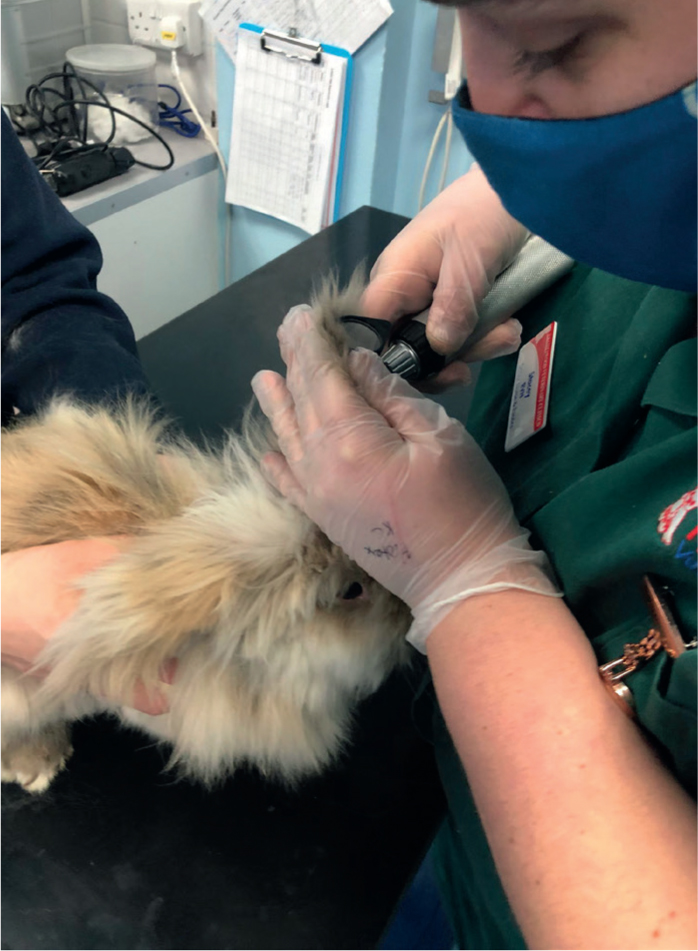
The eyes should be assessed to ensure the cornea is smooth and shiny, which indicates an appropriate tear film, and there is no conjunctivitis or ocular discharge. While discharge may not always be seen, hair stuck in clumps around the eye can be an indication that ocular discharge has been occurring (Figure 2). If required, an ophthalmoscope can be used to assess the internal structures of the eye. The nares should be symmetrical and dry, with no crusting or nasal discharge.
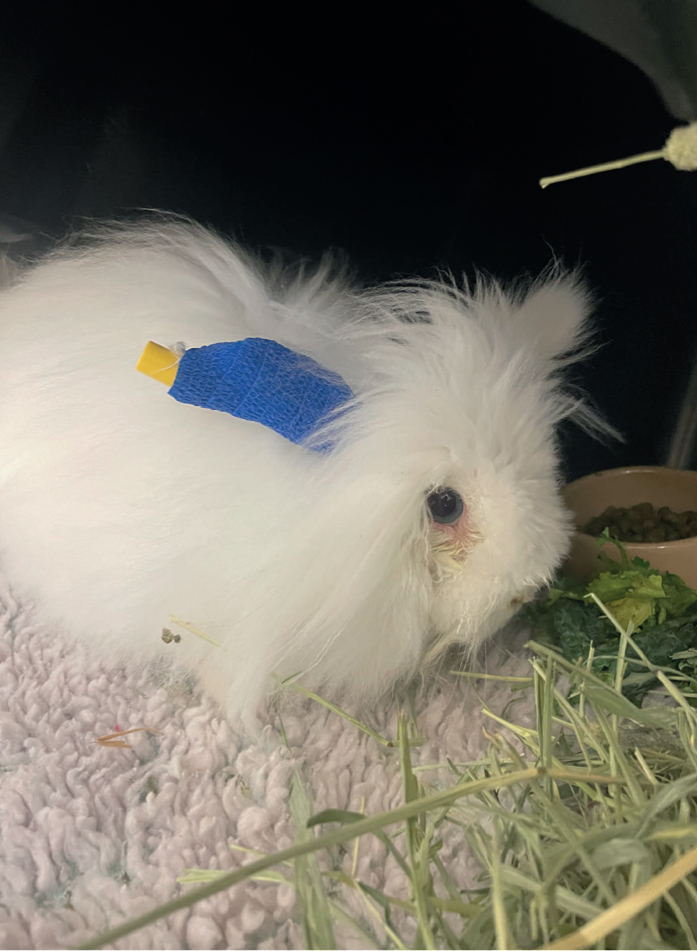
When assessing the mouth, first, part the upper lips and gently lift dorsally to expose the incisor teeth. These should be symmetrical and meet in a horizontal line, with the maxillary incisors sitting just rostral to the mandibular incisors. An otoscope with a cone or speculum head should be used to assess the molar teeth by gently inserting the instrument into both sides of the mouth, avoiding the incisor teeth (Figure 3). It is important to assess the buccal and lingual aspects of all four dental arcades. All teeth should be flat and even in wear, with no lingual or buccal overgrowth. The assessment of the buccal and lingual aspects allows the examination of the tooth crowns, but does not rule out molar root disease. Also examination can be made difficult when a rabbit is conscious if it moves the otoscope around with its tongue or shakes its head, so molar overgrowth towards the back of the mouth can sometimes be missed. Following this, examine the face, palpating around the nose and mandible for any evidence of swelling or abnormalities under the fur. Assess for facial symmetry — facial nerve paralysis is often seen in cases of otitis media with no other clinical signs.
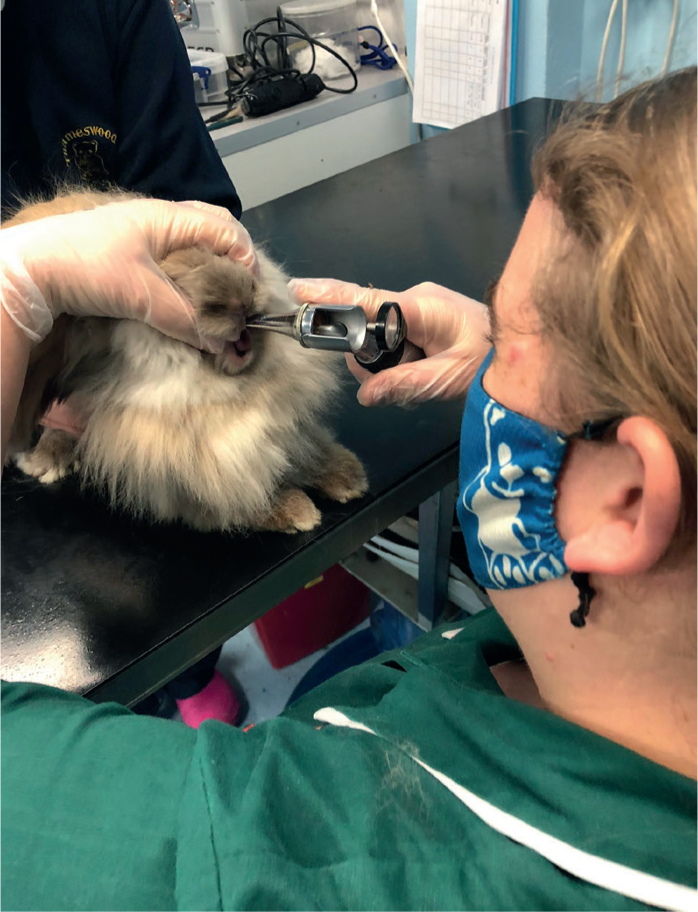
Teeth should be regularly checked in rabbits. Dental disease commonly has congenital and husbandry-related causes. Dental checks are required even when the rabbit is otherwise seemingly healthy as rabbits can manage with a surprising level of dental disease without showing any clinical signs. In some early stages, dental disease can be managed through correcting of husbandry, or it may require dental work under general anaesthesia. When assessing dentition of rabbits, it is good practice to assess healthy rabbits first to learn what is normal before looking for abnormalities. Otoscopic examination reveals approximately 80% of the teeth. Commonly seen issues include ulcerations of the tongue, buccal upper spurs and lingual lower spurs (Richardson, 2014). It should be recognised that when the molars and premolars are aligned, the incisors will be out of alignment and vice versa.
Examining the trunk and limbs
The chest should be auscultated on both sides to assess heart sounds and listen for any adventitious lung sounds. The abdomen should also be auscultated to ensure there are audible gut sounds throughout. The author scores these out of three for each abdominal quadrant. The abdomen should be gently palpated to assess for any swellings, gas distension of the gastrointestinal tract, presence of faeces in the colon or any areas of repeatable pain. The perineum should be examined for faecal contamination or urine scald, and the scent glands assessed to ensure they are not over-full. While the perineum is being examined, this is a good opportunity to assess the plantar aspect of the hind feet for evidence of pododermatitis (Figure 4). This is often overlooked in clinics and not noticed by the owner, as a small amount of fur may lie just over the top of the pododermatitis lesions. Each limb should be gently palpated, and joints gently taken through their range of motion. Gentle palpation along the spine can help identify any spinal pain and is particularly important if a gait abnormality has been previously identified.
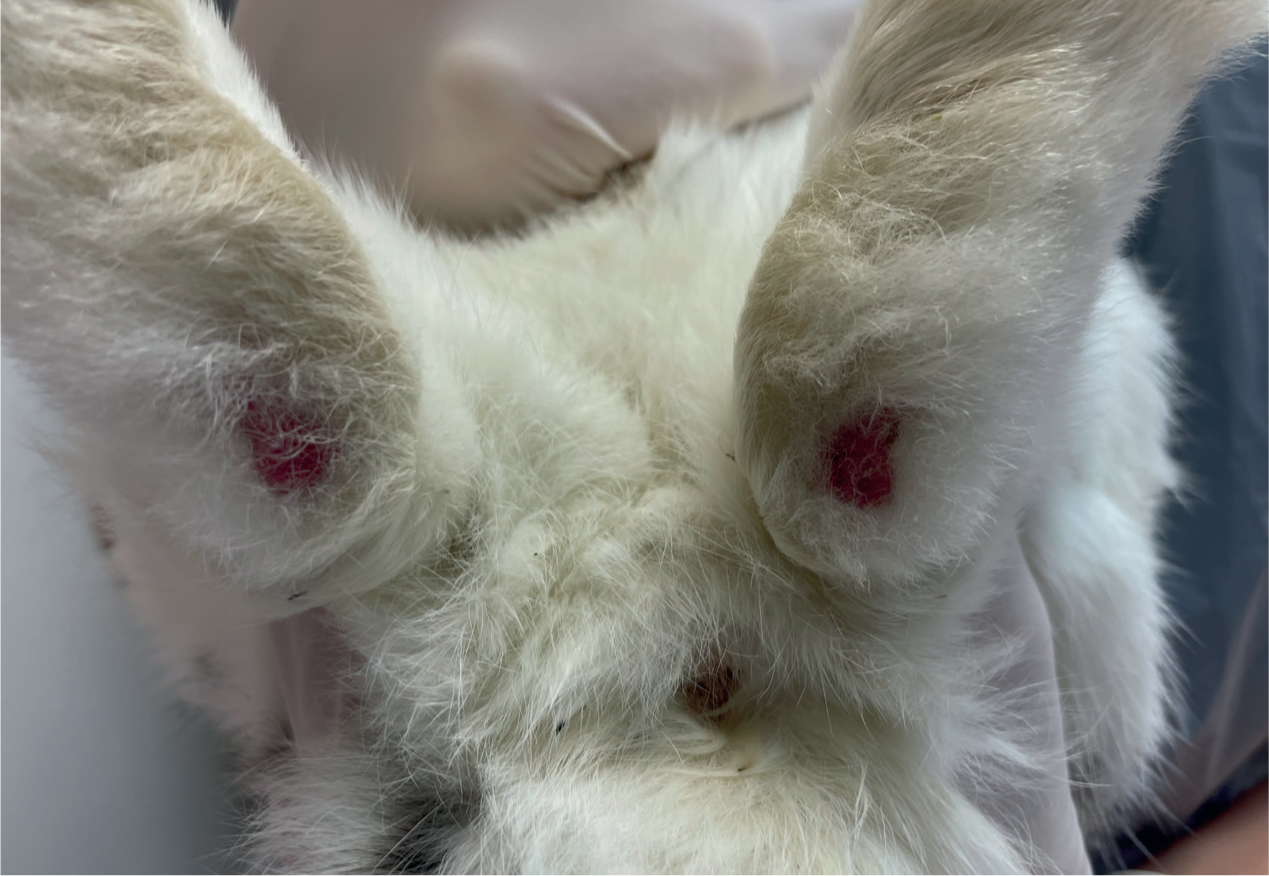
Pododermatitis is a common problem which goes undiagnosed in many rabbits. It is usually caused by unbalanced pressure on the hock of the foot. This allows pressure to build up and redness to occur which can develop into wounds and sores. Predisposing risk factors include the types of bedding used (Wolf et al, 2020) and certain rabbit breeds, examples include Rex rabbits and Netherland Dwarfs (Mancinell, 2015). Identifying this early on can make this condition easier to resolve by correcting the cause before it has developed into dermatitis that requires medical management.
Obesity is another common problem that owners may not notice. This can be hidden in longer haired rabbit breeds such as angoras, as they cannot have their body condition visually scored and require a hands-on assessment for all aspects. Obesity is commonly linked to reduction in exercise or incorrect diet, specifically diets high in carbohydrates and low in fibre, which are higher in calories (Adji et al, 2022). Reducing obesity is commonly achieved through including more exercise, providing higher fibre foods and increasing foraging behaviour to enable the patient to exert more energy in finding food. Compared with wild rabbits, domestic rabbits will spend considerably less time eating if the diet is too high in carbohydrates as energy is gained with minimal resource ingestion (Clauss and Hatt, 2017).
Handling considerations
Rabbits have relatively delicate skeletons, comprising only 7–8% of their body weight (Mader, 2004). Coupled with their powerful hind limb musculature, this presents a risk if a rabbit struggles during physical restraint. Surveys indicate that at least 57% of rabbits struggle when being lifted, and up to 7% of rabbits showed signs of fear when being handled by an unfamiliar human (Bradbury and Dickens, 2016). Rabbits should only be lifted if necessary, and should have one hand supporting the hindquarters and one hand supporting the thorax (Brandão et al, 2021). The authors recommend using three points of contact when carrying rabbits; as above, and also holding the rabbit in contact with the handler's chest.
Rabbits should be examined on a flat surface, ideally with non-slip matting or a towel. This is also important when weighing a rabbit, as most rabbit-sized weighing scales are smooth and rabbits can slip on these, resulting in injury (Figure 5). Towels can also be useful to wrap rabbits to prevent struggling during more invasive sections of the physical examination, such as a molar examination (Figure 6).
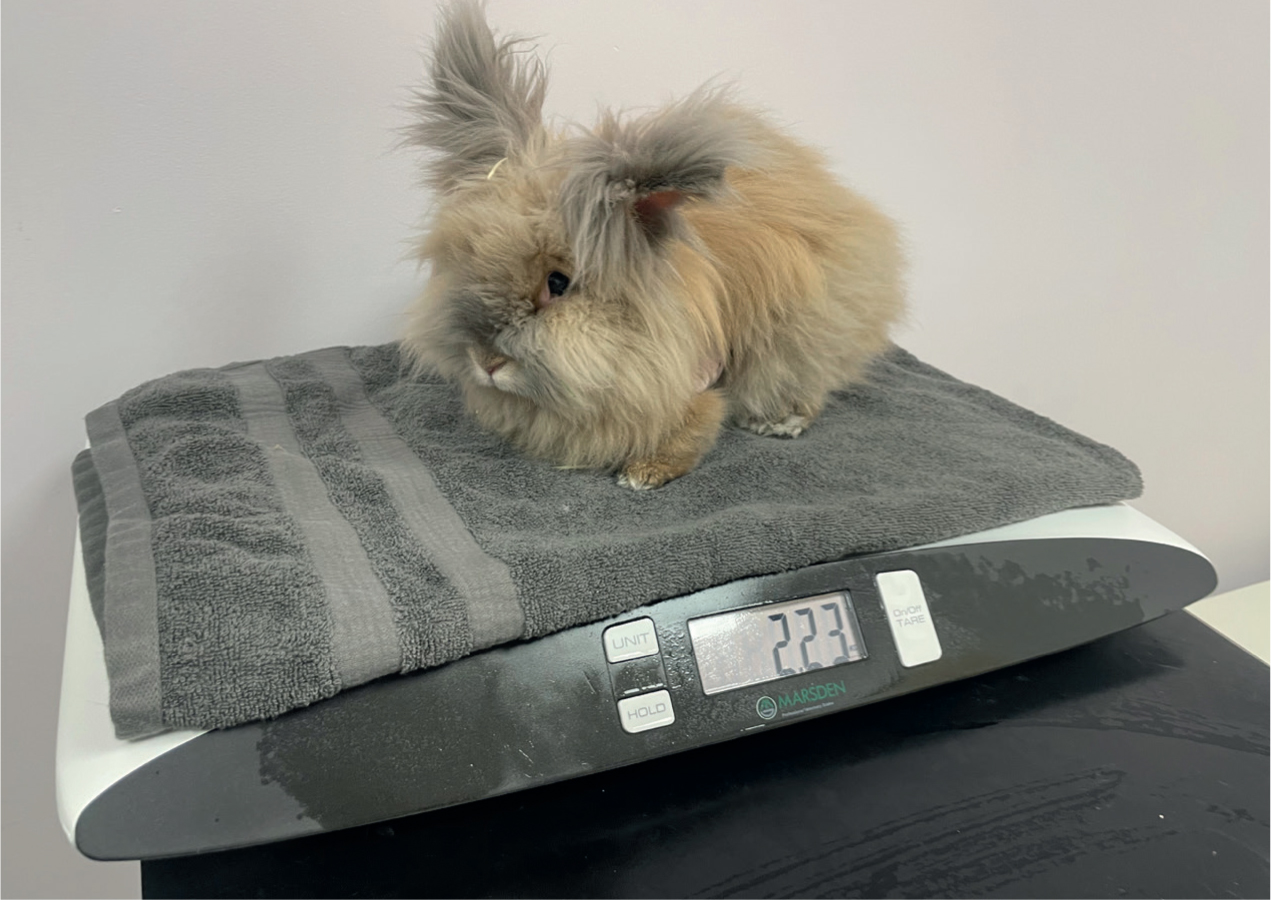
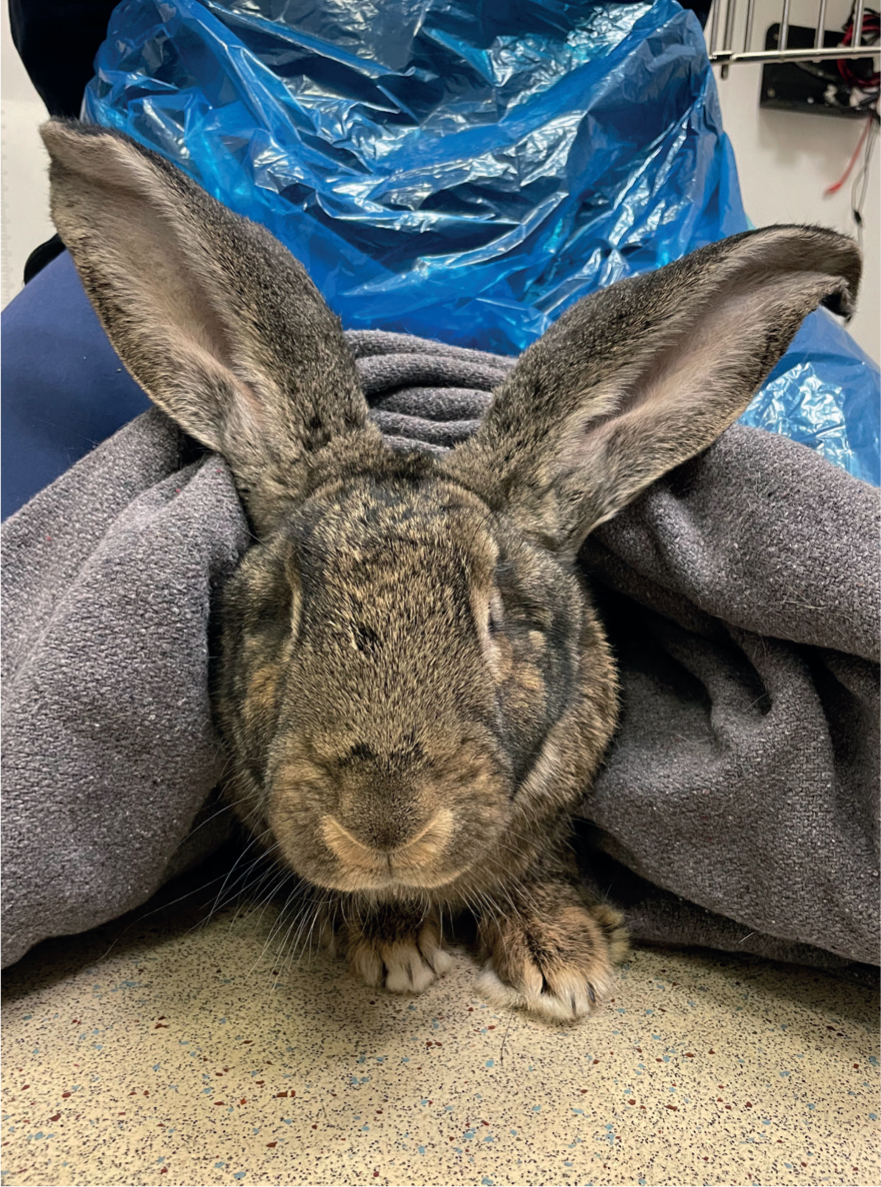
Preventative care
Preventative care should always be discussed with the owners at all consultations. There are many different preventative care measures that can be used. Some are limited to the veterinary environment, but some can be implemented in general husbandry by the owner.
Vaccinations are an important starting point for discussions with rabbit owners as they are may not be aware that vaccinations can be given to rabbits or the importance of these. Knowing about, and explaining, some of the preventable rabbit diseases (myxomatosis and rabbit viral haemor-rhagic disease) can help owners to understand how these are transmitted, their clinical signs in rabbits and their consequences. Discussing vaccination protocols can aid client compliance and thus the long-term welfare of the rabbit. The vaccination protocols that the practice uses should be made clear to the client so they know the expectations of follow-up boosters and what the different vaccines on the market are covering to enable a full informed decision.
Encephalitozoon cuniculi is a common microsporidian parasite that can be carried in rabbits without showing any signs or symptoms (Harcourt-Brown, 2004), or can develop signs later in life or concurrently with another condition. E. cuniculi is also a zoonotic disease and veterinary professionals have a responsibility to inform owners of this, as asymptomatic rabbits can still spread it (Lewis et al, 2012). It is also important to know how the rabbit could be affected if E. cuniculi was left untreated, with symptoms ranging from mild head tilt or neurological signs to kidney failure, cataracts, seizures and severe head tilts. E. cuniculi can be investigated through blood sampling for serology, to identify IgG and IgM levels, which indicate previous and/or current exposure, which can aid in guidance to their ability of shedding the pathogen and risk exposing other rabbits to it. Many laboratories can offer this testing service. Treatment is also available that can be administered by the owner. Fenbendazole is used for a 28-day course to cover the whole lifecycle of the pathogen (Harcourt-Brown, 2004. It can be beneficial for the owner to know about this to help reduce transmission risks between humans and other rabbits they may own or plan to own.
Flystrike is another disease that can be prevented by different methods. It is important to ensure owners are aware of the risks and causes. Flystrike is a sign of another problem, possibly husbandry or physiological, which increases the likelihood of the rabbit experiencing flystrike. This commonly occurs in conditions of poor hygiene such as a rabbit being unable to clean itself properly and remaining soiled (this could be a result of matting fur, arthritis, obesity or dental disease). It can also be from faeces left in a cage. This can happen even in clean cages which have some faeces; these attract flies which then lay eggs in the soiled matter and also on the rabbit. Flystrike can develop very quickly, and it is important to teach owners how to check for signs of flystrike and other coexisting factors. Prevention, such as the application of Rearguard® (Novartis Animal Health, London, UK), can also be discussed with owners and administered in nurse clinics. This can aid owner compliance with long-term care and prevention.
Educating clients on these preventable conditions and maintaining good healthcare, husbandry and handling can improve the connection the client has to the practice and create a good quality lifestyle for the rabbit.
Companionship
Every rabbit should be housed with a companion, as rabbits are social animals (Bays, 2020). Discussing bonding with owners is a great use of rabbit clinics, and rabbits that are being bonded can be brought to the clinic to interact in neutral territory. Discussing the need for a companion is often a good time to discuss neutering, if the rabbit is not already neutered. Not only does neutering prevent unwanted litters and unwanted sexual behaviours such as humping and spraying, but it can also prevent health problems in the future. Uterine adenocarcinoma in rabbits has an incidence as high as 80% in female rabbits over the age of 4 years (Di Girolamo and Selleri, 2021). Pyometra and hydrometra have also been reported in entire female rabbits and, although rare, testicular neoplasms have also been reported in male rabbits (Alexandre et al, 2010).
Diet
Rabbits require a high fibre diet, because of their continually growing teeth and the high degree of fermentation that occurs within the caecum. Rabbits should always be provided with ad libitum hay, with a small amount of green vegetables and a high-fibre pelleted feed (Clauss and Hatt, 2017). A rough recommendation for intake is 80% hay, 15% vegetables and 5% pellets and treats. As well as being high in fibre, hay also provides a positive calcium to phosphorus ratio (Clauss, 2012). It is common for owners to want to provide their pets with treats or human food, but rabbits' digestive tracts are not designed for low-fibre diets, and highly digestible foods start the fermentation process quicker, resulting in a change of the intestinal microbiome, which can lead to diarrhoea and in some cases death (Gidenne et al, 2004). Some vegetables and herbs can be high in calcium, which can lead to hypercalciuria. Rabbits absorb calcium from the gastrointestinal tract regardless of vitamin D status, then excrete all excess calcium via the kidneys, with fractional calcium excretion as high as 60% (Di Girolamo and Selleri, 2021). Calcium carbonate precipitates in the urine and causes a build-up of bladder ‘sludge’ or ‘sand’ (Figure 7).
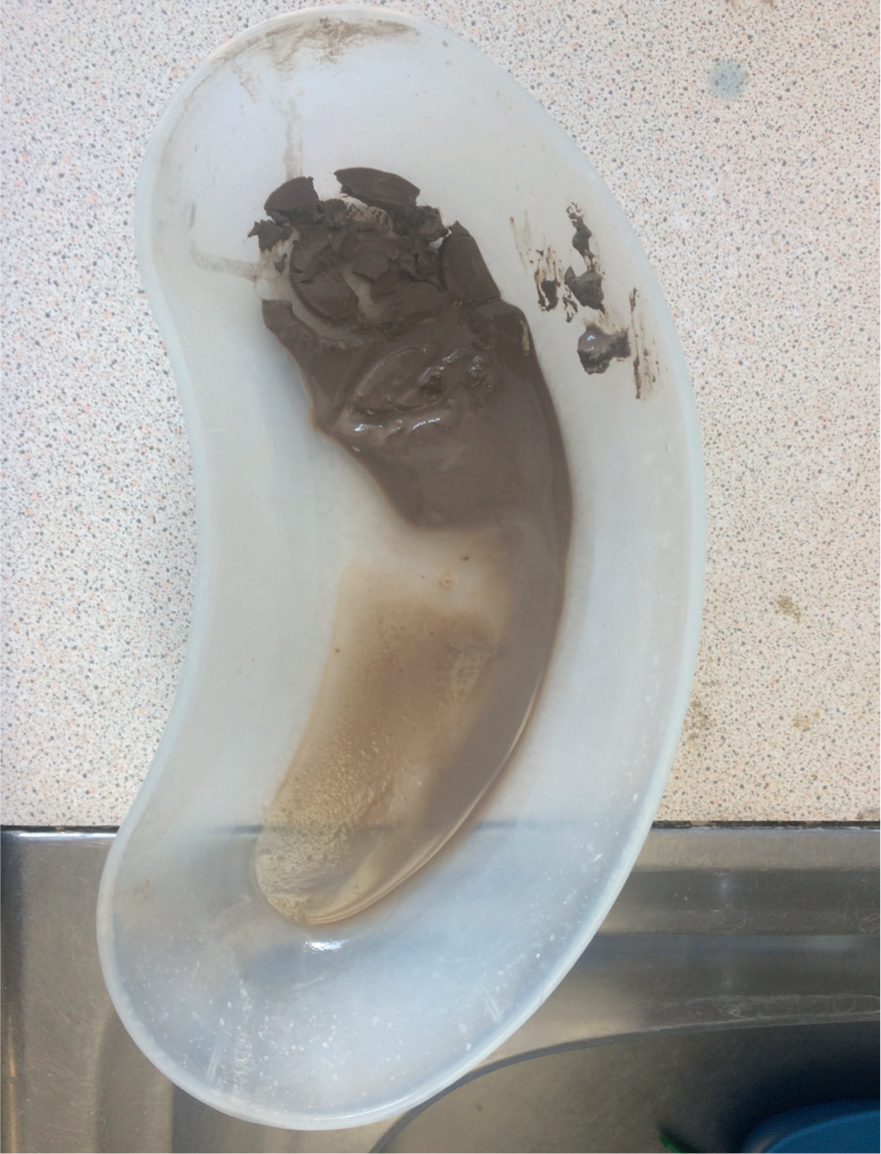
Rabbits perform coprophagy, where caecotrophs (microbial matter-based faeces separated by the caecum) are eaten directly from the anus (Clauss and Hatt, 2017). Clients should not see caecotrophs; the observation of caecotrophs in the environment (Figure 8) indicates increased dietary protein or starch (Fekete and Bokori, 1985), which requires correction, or obesity of the rabbit, which should be evident on physical examination. Feeding is usually observed in rabbits during the early morning and at dusk, with coprophagy commencing 3–8 hours after these times (Donnelly and Vella, 2021).
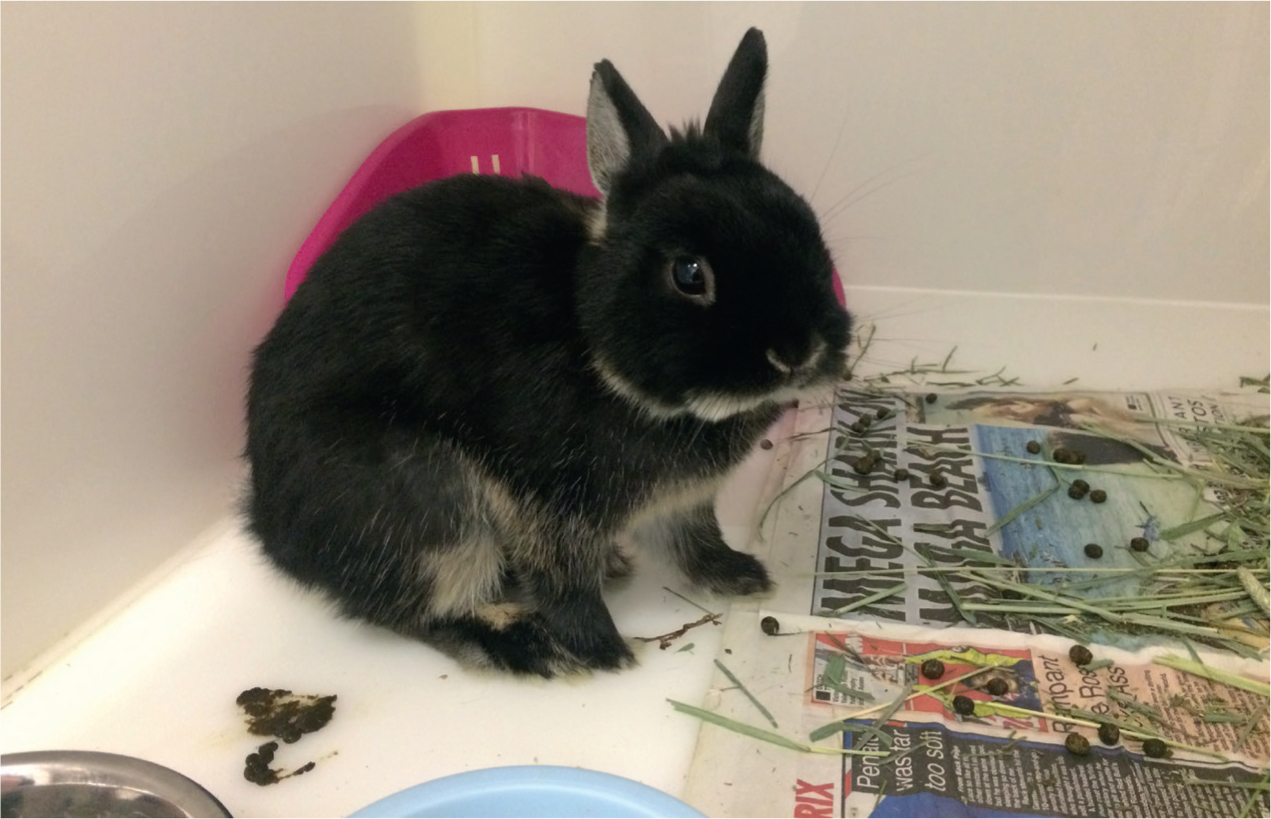
Geriatric rabbit clinics
Caring for a geriatric rabbit requires closer observation from the owner and the ability to provide husbandry and environmental changes to make life easier for the patient. Any owner that has a rabbit over the age of 7 years should be encouraged to bring the rabbit in for at least 6-monthly rabbit clinics to assess the health and quality of life. The older rabbits are, the higher the incidence of arthritis, renal disease and neoplasia (Bays, 2020). Older rabbits require a smaller portion of pellets in their diet to prevent obesity and to promote hay intake, which in turn helps with prevention of dental disease and gastrointestinal issues (Bays, 2020). Water should be provided in bowls rather than bottles (already recognised as a preference for rabbits of all ages), as this avoids the neck flexion required to reach up to a dripper bottle in animals that may have cervical spine arthritis.
Regular geriatric clinics can also help to identify deficiencies in grooming. Rabbits with arthritis or obese rabbits may not be able to reach around to their perineum and hind quarters to groom or perform coprophagy, which can result in faecal soiling. Rabbits that have arthritis sometimes have difficulty posturing to urinate and can accidentally urinate on themselves, which can cause urine scald. Additional litter trays should be provided for geriatric rabbits, ideally with low sides to enable easy access. Any patient that is showing difficulty posturing to urinate or defecate or has pain over the spine and/or hips should be evaluated for arthritis and treated accordingly. The home environment should be discussed with the client and any areas within the rabbit's environment that have poor traction, for example tiles or wooden floors, should be covered with carpet or towels to allow the patient to move around at home without fear of slipping. Hay and straw or sea grass matting can also provide excellent traction, as well as being edible and providing enrichment (Bays, 2020).
During a geriatric rabbit examination, ensure that the ears are assessed thoroughly for presence of wax or cerumen, as geriatric rabbits may be unable to use their back foot to clean within their ear canal. Excess wax can be gently cleaned, and an ear cleaner can be used by the client to clean the rabbit's ears at home. Decreased mobility can also be a factor in the development of pododermatitis in geriatric rabbits, alongside wet bedding, obesity and urine scalding (Lennox, 2010).
Engaging clients
Once the plan for rabbit clinics in the practice has been established, it is important to get clients on board. Advertising and marketing the rabbit services available is a key way to promote nursing abilities as well as the care and compassion which can be provided for rabbits. Social media, word of mouth and local advertising can be good ways to raise awareness of the clinics.
Structure in the clinics is important so that any nurse is able to run them, providing the same level of service to owners and ensuring that the process is not disjointed. If the same information and health checks are completed at each appointment (relevant to the reason for the appointment) then clients will gain a positive experience of a high standard from all the team, building confidence.
Charging for these nurse consultations should also be considered as Ackerman (2015) reported that this can bring more respect and benefits for the client. This would help them feel that they were getting value for money and gaining something for their fees. General first consultations are often not charged for, but where veterinary nurses use their skills and nursing experience, such as nail clipping, medicating and health checking, this should have a value attached to it and be charged for accordingly.
Conclusions
Rabbit clinics are an excellent way to interact with clients and to identify health issues in rabbit patients before they become chronic problems. Rabbit clinics can be run by nurses in any veterinary clinic and provide clients with well researched information. Special consideration should be given to running geriatric rabbit clinics, as these patients are prone to developing health conditions and require husbandry alterations to prevent or manage health issues.
KEY POINTS
- A full top-to-toe examination should be performed at each rabbit clinic as it could reveal subtle signs of clinical disease that can be treated before they become a problem.
- Patients should be handled carefully on a flat, non-slip surface and if the rabbit needs to be picked up it is recommended that the holder has three points of contact with the rabbit.
- Nursing clinics can be used to educate clients on preventable diseases such as myxomatosis, rabbit viral haemorrhagic disease, E. cuniculi and flystrike.
- Husbandry issues can be identified and corrected during nurse clinics, preventing the development of health issues such as dental disease, obesity and pododermatitis.
- Geriatric rabbit clinics should be promoted and encouraged, to identify health concerns in geriatric rabbits.


